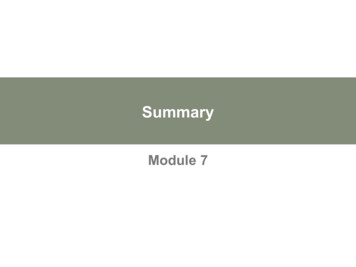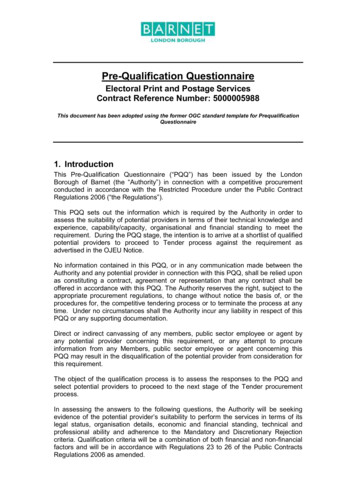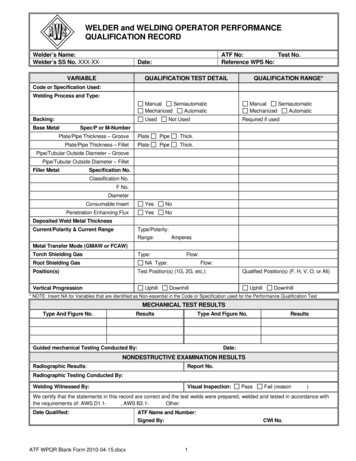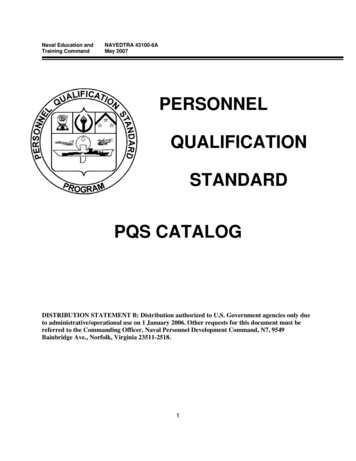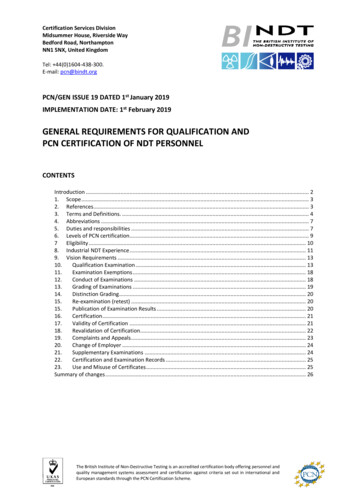
Transcription
Space Qualification Plan ofOptoelectronic and Photonic Devices forOptical Communication SystemsQuiesup KimJet Propulsion LaboratoryCalifornia Institute of TechnologyPasadena, CA 91109-8099Kargaret L. Tuma, GRCCarl Magee, LaRCQuiesup Kim/NEPP/05/16/011
Purpose To characterize newly available photonic devicesneeded for the future space missions (opticalcommunications with spacecrafts (i.e. InternationalSpace Station)/ spectrometers) and develop spacequalification guidelinesTo establish a space qualification plan of a newlydeveloped InGaAs Active Pixel PIN Receiver devices,and identify the advantages over the existing stateof-the-art photonic receiver devicesQuiesup Kim/NEPP/05/16/012
Presentation outline PurposeQualification MethodologyReceiversQualification VariablesSpace Qualification PlanConclusionsRecommendationsQuiesup Kim/NEPP/05/16/013
Methodology: Space Qualification ofInGaAs/InP Active Pixel ReceiversMars Exploration RoversDeep Space CommunicationsProcess QualificationCustomized InGaAs/InP DieFP/FProduct QualificationPackaged 320x240 Array entationProcessIdentificationDocumentationProduct AcceptanceQuiesup Kim/NEPP/05/16/014
ApplicationsTracking System Proper Orientation Relative tothe Arriving Optical Field. Closed Loop tracking ControlSystems (Azimuth, Elevation).Multifunctional ActiveSpectral Analyzer(MAESA) Obtain a wavelength-resolvedcharacteristic spectrum of thetarget for its identification. Obtain temporal and spatialmultifunctional informationof the same targetQuiesup Kim/NEPP/05/16/015
Process QualificationDetermine Type of DeviceEstablish TRBDevelop Processing StepsDevelop and DocumentStandard Workmanship,Management Procedures andMaterial Tracking Procedures.Document Design Standard andProcessing ProceduresDetermine Fabricate Technology Vehicle, Circuits, and Partsto be qualifiedDetermine Device Models,Electrical Circuits, and PartsProcess Reliability EvaluationProcess QualifiedQuiesup Kim/NEPP/05/16/016
Product Qualification External Visual InspectionLot Acceptance Test for DieDie mounting and Wire BondingNondestructive Bond Pull TestPre-ca Visual InspectionSerialization and MarkingInfrared ScanSeal TestTemperature Cycle/Shock TestVibration/Sock TestParticle Impact Noise DetectionElectrical/Optical Test at High/Low TemperaturePre Electrical/OpticalBurn-inHermetic Seal TestRadiographic InspectionFinal Electrical/OpticalQuiesup Kim/NEPP/05/16/017
Typical Packaged Device ScreeningTestNondestructive bond pullInternal visual inspectionIR-scan (prior to seal)Temperature cycling/Thermal shockMechanical shock/Constant accelerationParticle impact noise detectionElectricalBurn-inElectrical (high/low temp)Fine leakGross leakRadiographicExternal visualReferenceMIL-STD-883, Method 2023MIL-STD-883, Method 2017JEDEC Document JES2 [7]MIL-STD-883, Method 1010/MIL-STD-883, Method I 01 IMIL-STD-883, Method 2002/MIL-STD-883 Method 2001MIL-STD-883, Method 2020Customer's specificationMIL-STD-883, Method 1015Customer's specificationMIL-STD-883, Method 1014MIL-STD-883, Method 1014MIL-STD-883, Method 2012MIL-STD-883, Method 2009Quiesup Kim/NEPP/05/16/018
Space Qualification Plan This qualification plan covers the general provisions forphotonic devices intended for use in in-situ materialanalyses/detector system applications. The qualification plan should include optical as well aselectrical for all the photonic devices such as: laser diodes (single/multiple modes) PIN receiver diodes and transistors fibers ( single/multiple mode) Index guides: p-InP/n-InGaAs/p-InP Opto-couplers Optical amplifiers Optical switchesQuiesup Kim/NEPP/05/16/019
Optical Receivers Devices– Photo-gate– Photodiode– Avalanche Photodiodes Readout Circuits– Amplify– Switching– 2-D Data processesQuiesup Kim/NEPP/05/16/0110
The State-of-the-Art DetectorsSi APDGe-APDInGaA/InP APDInGaAs-PD/FETλ (microns)0.5-1.00.8 - 1.51.251.0 -1.7η max0.80.80.80.8i d (A)1.00E-111.00E-061.00E-091.00E-09Cj (pF)1112F3007030τ r (ns)0.150.16Quiesup Kim/NEPP/05/16/010.0611
Active Pixel Sensor (APS)Single Stage Buried Channel Junction CCDQuiesup Kim/NEPP/05/16/0112
Active Pixel SensorsQuiesup Kim/NEPP/05/16/0113
A Typical Monolithic IntegrationQuiesup Kim/NEPP/05/16/0114
Key Reliability Factors Major critical variables to qualify the receiver are: Detectivity (D* 1012cm(Hz)1/2/W at a temperature of 200K) Lifetime Operating Temperature (-100 125 oC,10o C/half life) Bias Current/Voltage Output power Data Rates: 50Mb/s Spectral width (0.5 2.5 µm) DislocationsMetal diffusionInner material DegradationsPoint DefectsCrystal structures vacanciesAlGaAs/GaAs InGaAs(P)/InP110 Crystal axisImpurity level of the materialWorkmanship/reproducibilityRadiation DamagesTotal Ionizing Dose (25K Rad)Replacement Damage ( 25K Rad)Single Event Upsets (75MeV/mg/cm2)Single Event Latch upsSingle Event Burn outsModulation Transfer Functions Surface DegradationsFacet oxidation/slowAluminum/inhibit diffusion: AlGaAs/GaAsOutput power: 200mWCatastrophic optical damage/fastFacet melting: AlGaAs InGaAs/InPBandgap shrinking: non-absorbing mirror ( 0.1 MW/cm2)Alloy electrodesMetal diffusionAuZnNi: Dark spot defectsSchottky type electrode: TiPtAuBonding partsSoft solders: In, Sn, and Au rich solders/sudden failuresHard solders: Au rich solders/reduce instabilityOptical degradation/ModesLifetimeQuiesup Kim/NEPP/05/16/0115
Lifetime1.1Normalized Intensity 00Time (Hours)Quiesup Kim/NEPP/05/16/0116
Summary of Lifetime Monolithic Integration– Front Illumination Possible– Remove the Hybridization– Low-power, Low-cost, and Miniaturization Possible Active Pixel Smart Control– Direct Addressing– Remove the Needs of Multiplexers– Fast Data Processing Two-dimensional APS– Dual Function Imaging Possible– Spectrometer/Laser Image Detection and Ranging– Real-time Data Processing PossibleQuiesup Kim/NEPP/05/16/0117
Modulation Transfer Function In-situ evaluation of advanced active pixel focal planearrays by Modulation Transfer Function in differentstages of imager system developments is necessary foran ideal design of different sensors and their signalprocessing. Understanding the tradeoff between different figuresof merit will enable designers to achieve the mostefficient array design for specific missions.Quiesup Kim/NEPP/05/16/0118
Modulation Transfer Functions Modulation Transfer Function Active Imaging Focal Plane Arrays Cross talks Advanced Photodiode Active Pixel Test Chip Optical probing system ResultsQuiesup Kim/NEPP/05/16/0119
Modulation Transfer Function (MTF)MTF MTFoptical x MTFpixel .Ideal imaging system MTF is given by the product of the optical diffraction limited MTF of the opticsand the ideal MTF of the pixel.For circular aperture, the diffraction-limited MTF of the optics is circular symmetric. Its onedimensional profile can be given as:MTFoptical(f/fc) 2/ππ { cos-1(f/fc) - f/fc[1 - (f/fc)2]1/2 },for all fc f andzero otherwise.The cutoff frequency fc is related as 1/(f/#). The ideal pixel MTF is the magnitude of the Fouriertransform of the a rectangular function of width W or height of the active area of the pixel can beexpressed as:MTFpixel (f) sin(ππ f W)/ π f W .The real pixel MTF is depend upon many variables such as charge transfer efficiency (CTE), cross talk,pixel fill factor, pixel shape, and readout electronics including time delay integration (TDI) techniques.Quiesup Kim/NEPP/05/16/0120
Ideal MTFQuiesup Kim/NEPP/05/16/0121
Discrete Fourier Transformationsfor Modulation Transfer Function (MTF)Xd ( k f ) t Σ n 0 N-1 x(n t ) exp { - j 2ππ k f n t }whereN: number of samples being considered, t: the time between samples, f: the sample interval in the frequency domain,n: the time sample index,k: the index for the computed set of discrete frequency domain,j: ( - 1) 1/2.Quiesup Kim/NEPP/05/16/0122
Typical crosstalk among the eight nearestneighbor pixels is 5.1%Quiesup Kim/NEPP/05/16/0123
Block diagram of the Microelectronic AdvancedLaser ScannerQuiesup Kim/NEPP/05/16/0124
DICE APD CHIP PIXEL ARRAYQuiesup Kim/NEPP/05/16/0125
Active test pixel arrays used for the MTFmeasurements01,0002,000Column (X)020406080 100 1201201008060Rows (Y)40202,0000 1,0000Quiesup Kim/NEPP/05/16/0126
Procedure of the MTF Measurements A Single image containing an edge was stored for location of theedge. Utilizing the linear regression line fitting, the edge spread function(ESF) was determined as:F (x) D A / [ exp {(B-x) / C} 1]where A, B, C, and D are constants. Calculate the line spread function (LSF) by differentiate the ESF. Perform the discrete Fourier transformation (DFT) of the LSF forMTF of the one-dimensional focal plane array. The real part ofthe DFT is the MTF.Quiesup Kim/NEPP/05/16/0127
Edge Spread Function2,0001,800Intensity (Arb. 35PixelsQuiesup Kim/NEPP/05/16/0128
Modulation Transfer FunctionQuiesup Kim/NEPP/05/16/0129
Modulation Transfer FunctionQuiesup Kim/NEPP/05/16/0130
Modulation Transfer FunctionQuiesup Kim/NEPP/05/16/0131
Modulation Transfer FunctionQuiesup Kim/NEPP/05/16/0132
Summary of the MTF The performance of active pixel focal plane arrays is characterized byestimating their spatial frequency responses. A modified knife-edgetechnique that estimates 1-dimensional system MTF profiles is used. Advantages of the technique include the need for only a single image toperform the measurement in each direction and the fact that movingparts and high-precision alignment are not necessary. Various silicon active pixel sensor array responses that are not affectedby the charge transfer efficiency (CTE) were measured and comparedwith calculated MTF profiles in both the horizontal and verticaldirections. Calculated ideal pixel MTF of the different fill factor was comparedwith measured MTF and overall pixel crosstalk effects. Furthermore, itwas demonstrated that the technique can be utilized as a timelyevaluation technique of the focal plane array pixel design.Quiesup Kim/NEPP/05/16/0133
Conclusions General overview of Space qualification of Optoelectronicand Photonic Devices for space opticalcommunications/Spectrometer was described. Efforts were concentrated to generate the needed generalguideline of the optical reliability concerns. Ultimate goal for this effort is to gradually establishenough data to develop a space qualification plan ofnewly developed photonic specific parts. A numerical model to assess the lifetime and MTF asqualification variablesQuiesup Kim/NEPP/05/16/0134
AcknowledgementsThe author is grateful to their numerous colleagues including JohnS. Koehler, Charles H. Ho and Chris Wrigley of JPL for providingtechnical assistance for this paper.The study described in this report was carried out by the Centerfor Space Microelectronics Technology, Jet Propulsion Laboratory,California Institute of Technology, under a contract with theNational Aeronautics and Space Administration. Reference hereinto any specific commercial product, process, or service by tradename, trademark, manufacturer, or otherwise, does not constituteor imply endorsement by the United States Government or the JetPropulsion Laboratory, California Institute of Technology.Quiesup Kim/NEPP/05/16/0135
The ideal pixel MTF is the magnitude of the Fourier transform of the a rectangular function of width W or height of the active area of the pixel can be expressed as: MTFpixel (f) sin(π f W)/ π f W . The real p
